Project and Risk Management: Processes and Analysis - University
VerifiedAdded on 2022/09/26
|6
|863
|16
Project
AI Summary
This project delves into the core principles of project and risk management, providing a comprehensive analysis of essential processes. The assignment addresses key aspects such as establishing a risk register, identifying potential project threats, and assessing their impact and likelihood. It also includes practical examples, such as a sample risk register for a Mars mission, illustrating how to identify and mitigate specific risks. Furthermore, the project differentiates between qualitative and quantitative risk analysis, explaining when each approach is most appropriate and why qualitative analysis is a fundamental step in risk management. The student's work demonstrates a strong understanding of risk management methodologies, offering valuable insights into project success.
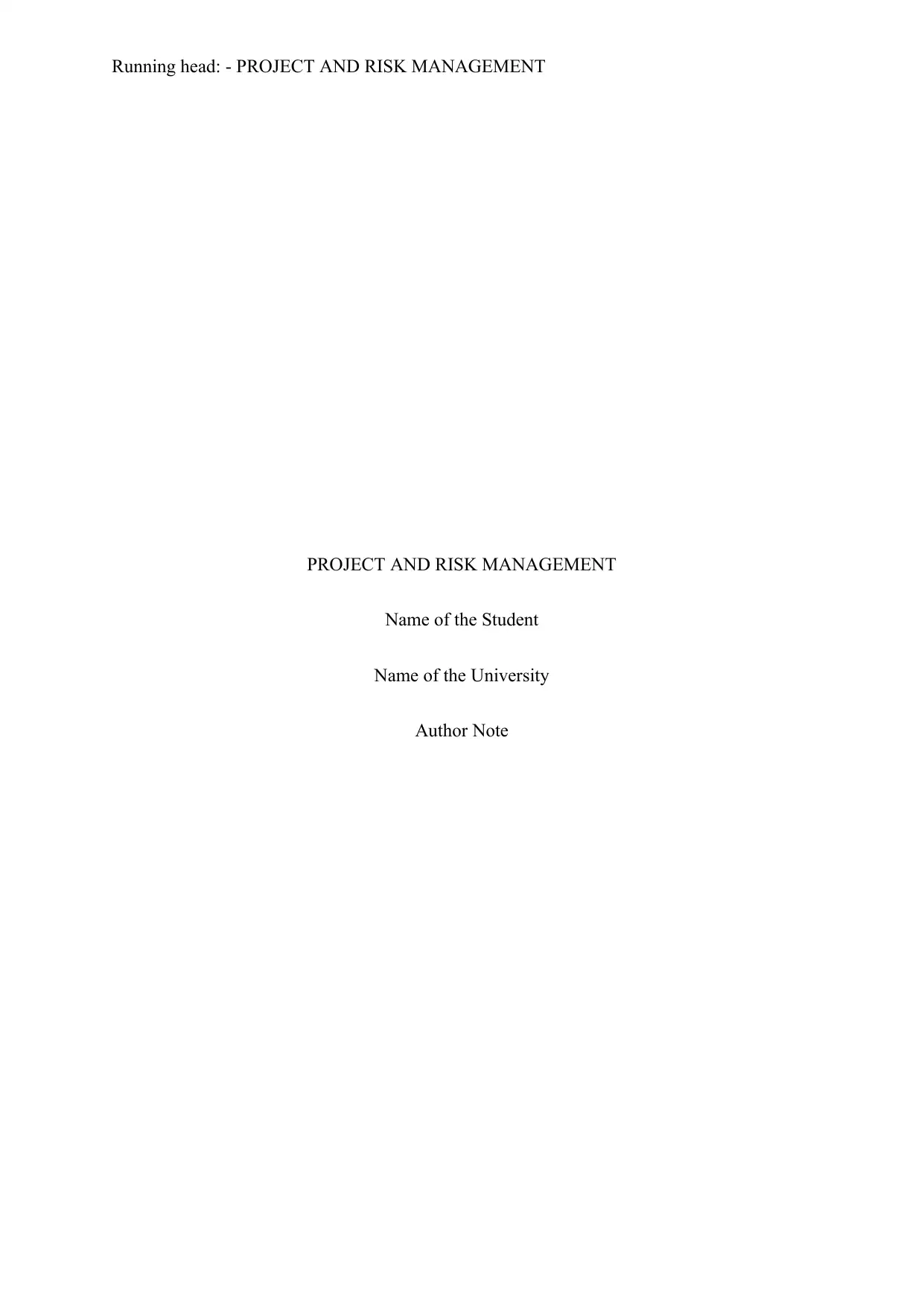
Running head: - PROJECT AND RISK MANAGEMENT
PROJECT AND RISK MANAGEMENT
Name of the Student
Name of the University
Author Note
PROJECT AND RISK MANAGEMENT
Name of the Student
Name of the University
Author Note
Paraphrase This Document
Need a fresh take? Get an instant paraphrase of this document with our AI Paraphraser
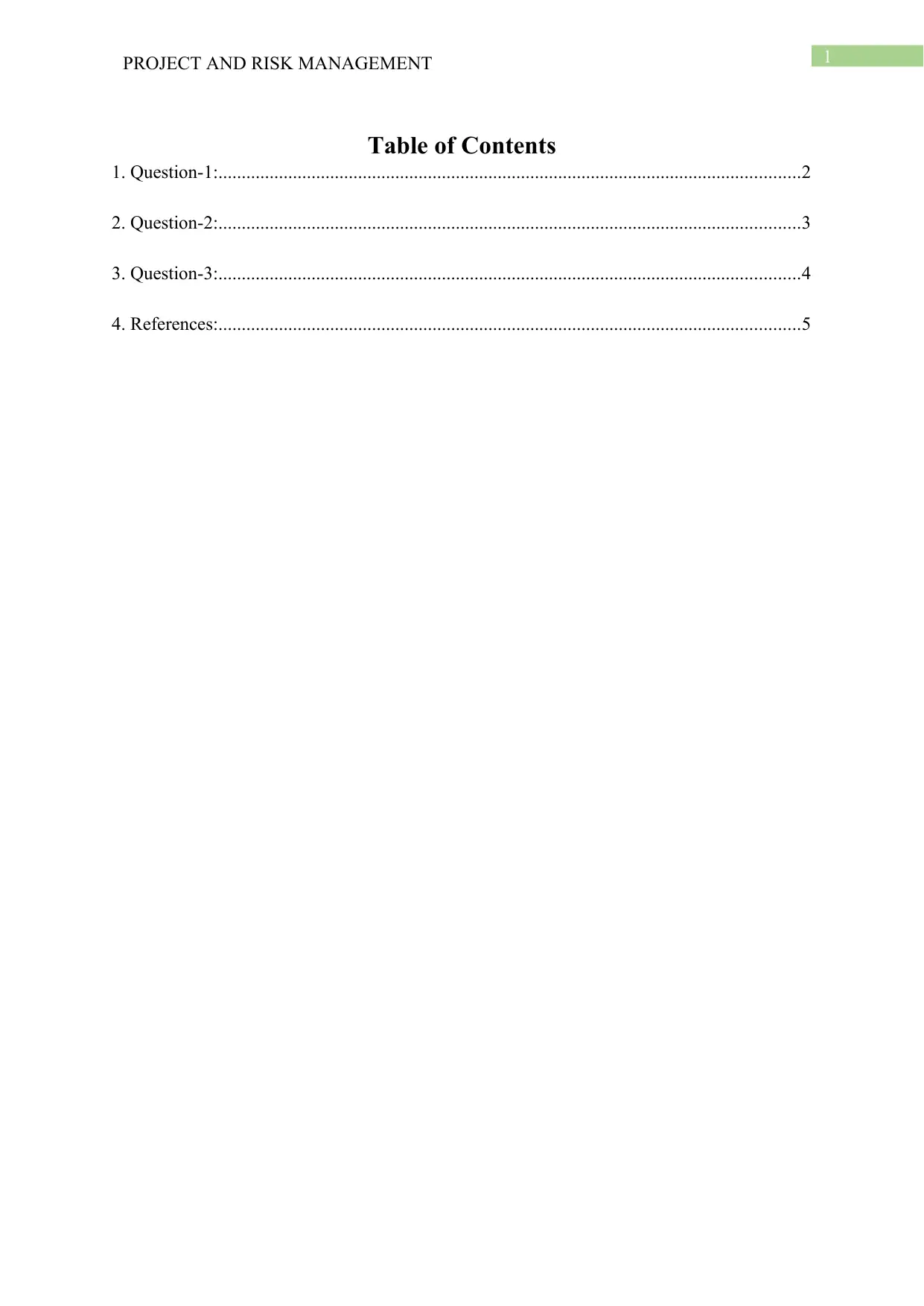
1PROJECT AND RISK MANAGEMENT
Table of Contents
1. Question-1:.............................................................................................................................2
2. Question-2:.............................................................................................................................3
3. Question-3:.............................................................................................................................4
4. References:.............................................................................................................................5
Table of Contents
1. Question-1:.............................................................................................................................2
2. Question-2:.............................................................................................................................3
3. Question-3:.............................................................................................................................4
4. References:.............................................................................................................................5
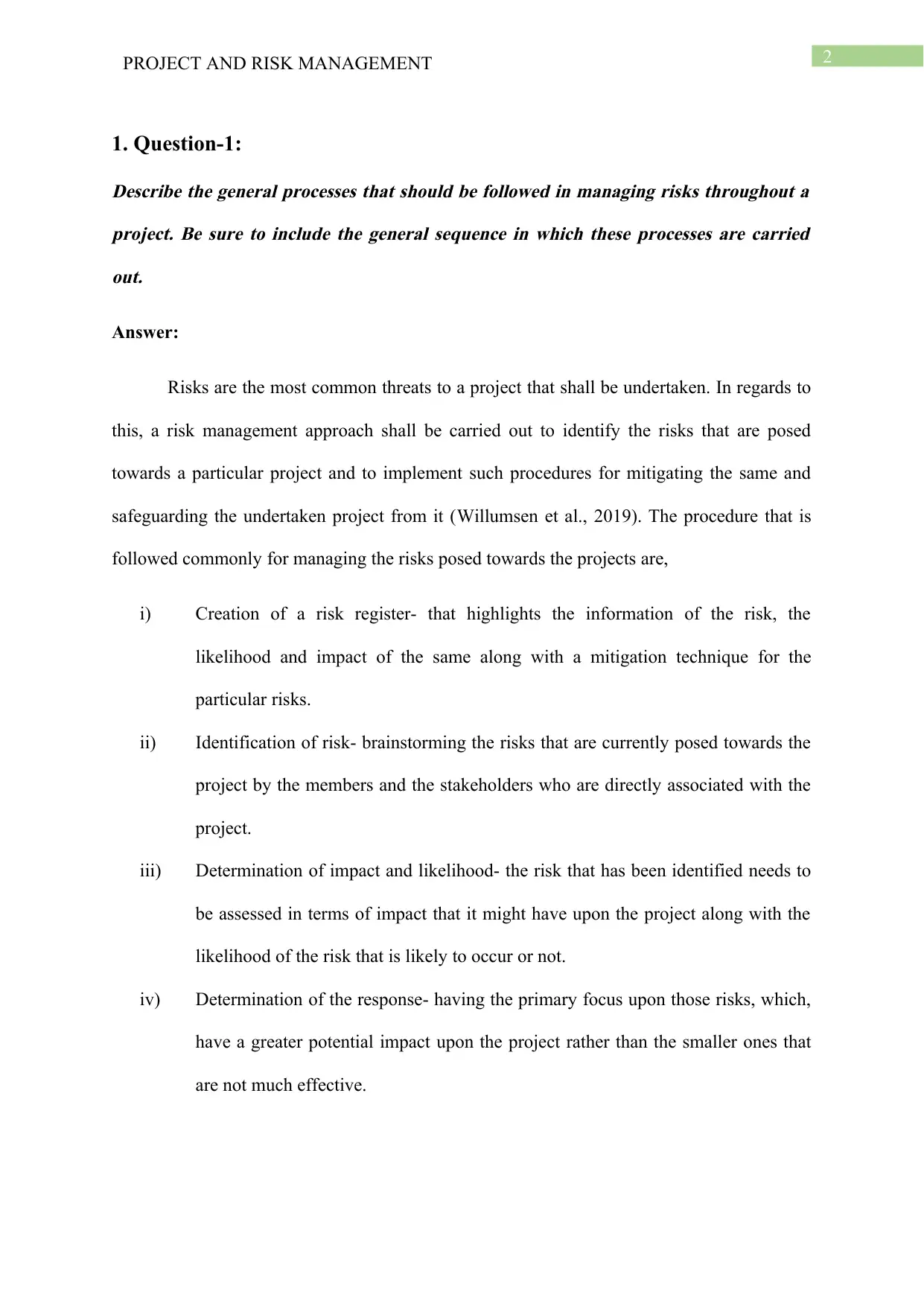
2PROJECT AND RISK MANAGEMENT
1. Question-1:
Describe the general processes that should be followed in managing risks throughout a
project. Be sure to include the general sequence in which these processes are carried
out.
Answer:
Risks are the most common threats to a project that shall be undertaken. In regards to
this, a risk management approach shall be carried out to identify the risks that are posed
towards a particular project and to implement such procedures for mitigating the same and
safeguarding the undertaken project from it (Willumsen et al., 2019). The procedure that is
followed commonly for managing the risks posed towards the projects are,
i) Creation of a risk register- that highlights the information of the risk, the
likelihood and impact of the same along with a mitigation technique for the
particular risks.
ii) Identification of risk- brainstorming the risks that are currently posed towards the
project by the members and the stakeholders who are directly associated with the
project.
iii) Determination of impact and likelihood- the risk that has been identified needs to
be assessed in terms of impact that it might have upon the project along with the
likelihood of the risk that is likely to occur or not.
iv) Determination of the response- having the primary focus upon those risks, which,
have a greater potential impact upon the project rather than the smaller ones that
are not much effective.
1. Question-1:
Describe the general processes that should be followed in managing risks throughout a
project. Be sure to include the general sequence in which these processes are carried
out.
Answer:
Risks are the most common threats to a project that shall be undertaken. In regards to
this, a risk management approach shall be carried out to identify the risks that are posed
towards a particular project and to implement such procedures for mitigating the same and
safeguarding the undertaken project from it (Willumsen et al., 2019). The procedure that is
followed commonly for managing the risks posed towards the projects are,
i) Creation of a risk register- that highlights the information of the risk, the
likelihood and impact of the same along with a mitigation technique for the
particular risks.
ii) Identification of risk- brainstorming the risks that are currently posed towards the
project by the members and the stakeholders who are directly associated with the
project.
iii) Determination of impact and likelihood- the risk that has been identified needs to
be assessed in terms of impact that it might have upon the project along with the
likelihood of the risk that is likely to occur or not.
iv) Determination of the response- having the primary focus upon those risks, which,
have a greater potential impact upon the project rather than the smaller ones that
are not much effective.
⊘ This is a preview!⊘
Do you want full access?
Subscribe today to unlock all pages.

Trusted by 1+ million students worldwide
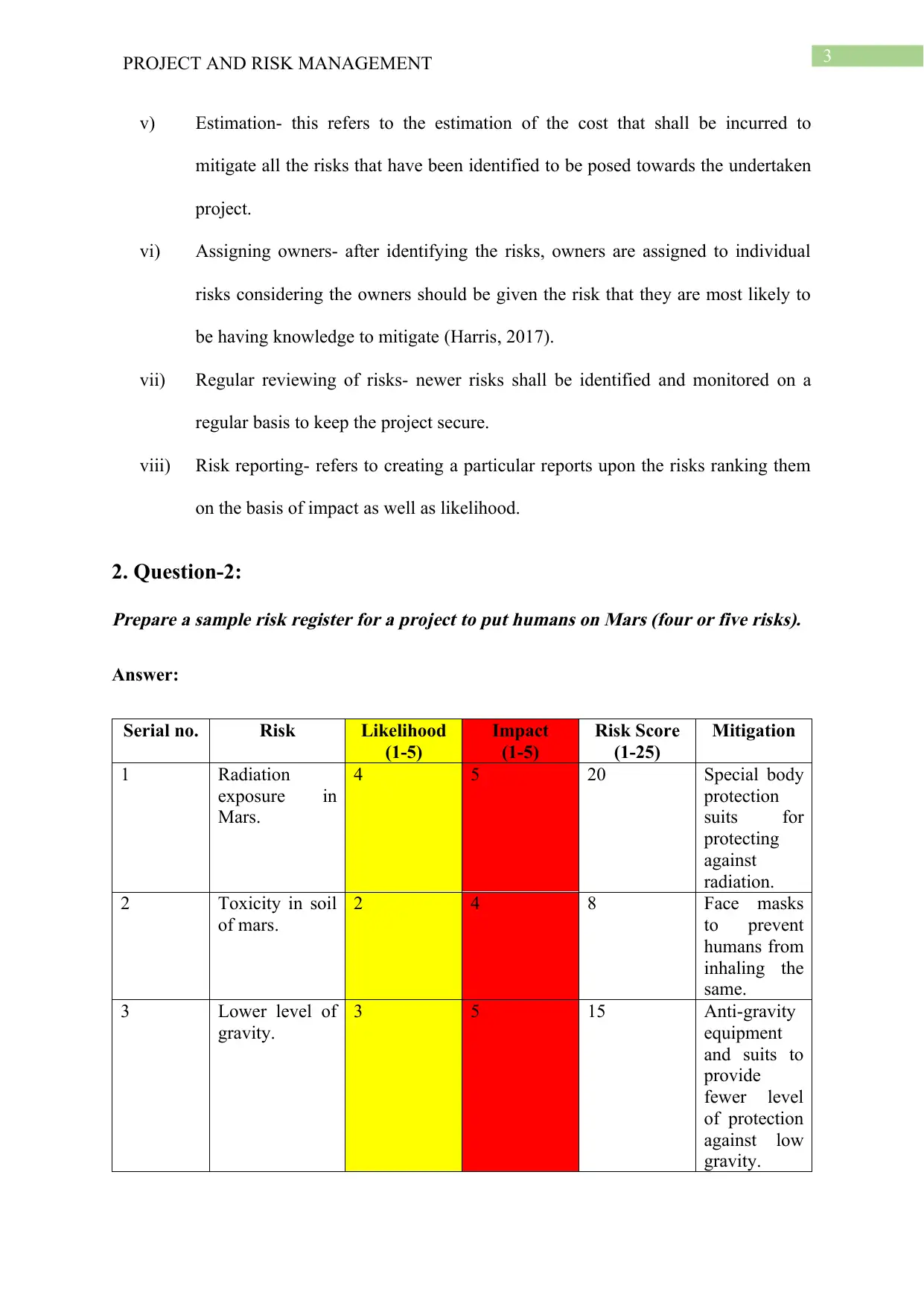
3PROJECT AND RISK MANAGEMENT
v) Estimation- this refers to the estimation of the cost that shall be incurred to
mitigate all the risks that have been identified to be posed towards the undertaken
project.
vi) Assigning owners- after identifying the risks, owners are assigned to individual
risks considering the owners should be given the risk that they are most likely to
be having knowledge to mitigate (Harris, 2017).
vii) Regular reviewing of risks- newer risks shall be identified and monitored on a
regular basis to keep the project secure.
viii) Risk reporting- refers to creating a particular reports upon the risks ranking them
on the basis of impact as well as likelihood.
2. Question-2:
Prepare a sample risk register for a project to put humans on Mars (four or five risks).
Answer:
Serial no. Risk Likelihood
(1-5)
Impact
(1-5)
Risk Score
(1-25)
Mitigation
1 Radiation
exposure in
Mars.
4 5 20 Special body
protection
suits for
protecting
against
radiation.
2 Toxicity in soil
of mars.
2 4 8 Face masks
to prevent
humans from
inhaling the
same.
3 Lower level of
gravity.
3 5 15 Anti-gravity
equipment
and suits to
provide
fewer level
of protection
against low
gravity.
v) Estimation- this refers to the estimation of the cost that shall be incurred to
mitigate all the risks that have been identified to be posed towards the undertaken
project.
vi) Assigning owners- after identifying the risks, owners are assigned to individual
risks considering the owners should be given the risk that they are most likely to
be having knowledge to mitigate (Harris, 2017).
vii) Regular reviewing of risks- newer risks shall be identified and monitored on a
regular basis to keep the project secure.
viii) Risk reporting- refers to creating a particular reports upon the risks ranking them
on the basis of impact as well as likelihood.
2. Question-2:
Prepare a sample risk register for a project to put humans on Mars (four or five risks).
Answer:
Serial no. Risk Likelihood
(1-5)
Impact
(1-5)
Risk Score
(1-25)
Mitigation
1 Radiation
exposure in
Mars.
4 5 20 Special body
protection
suits for
protecting
against
radiation.
2 Toxicity in soil
of mars.
2 4 8 Face masks
to prevent
humans from
inhaling the
same.
3 Lower level of
gravity.
3 5 15 Anti-gravity
equipment
and suits to
provide
fewer level
of protection
against low
gravity.
Paraphrase This Document
Need a fresh take? Get an instant paraphrase of this document with our AI Paraphraser
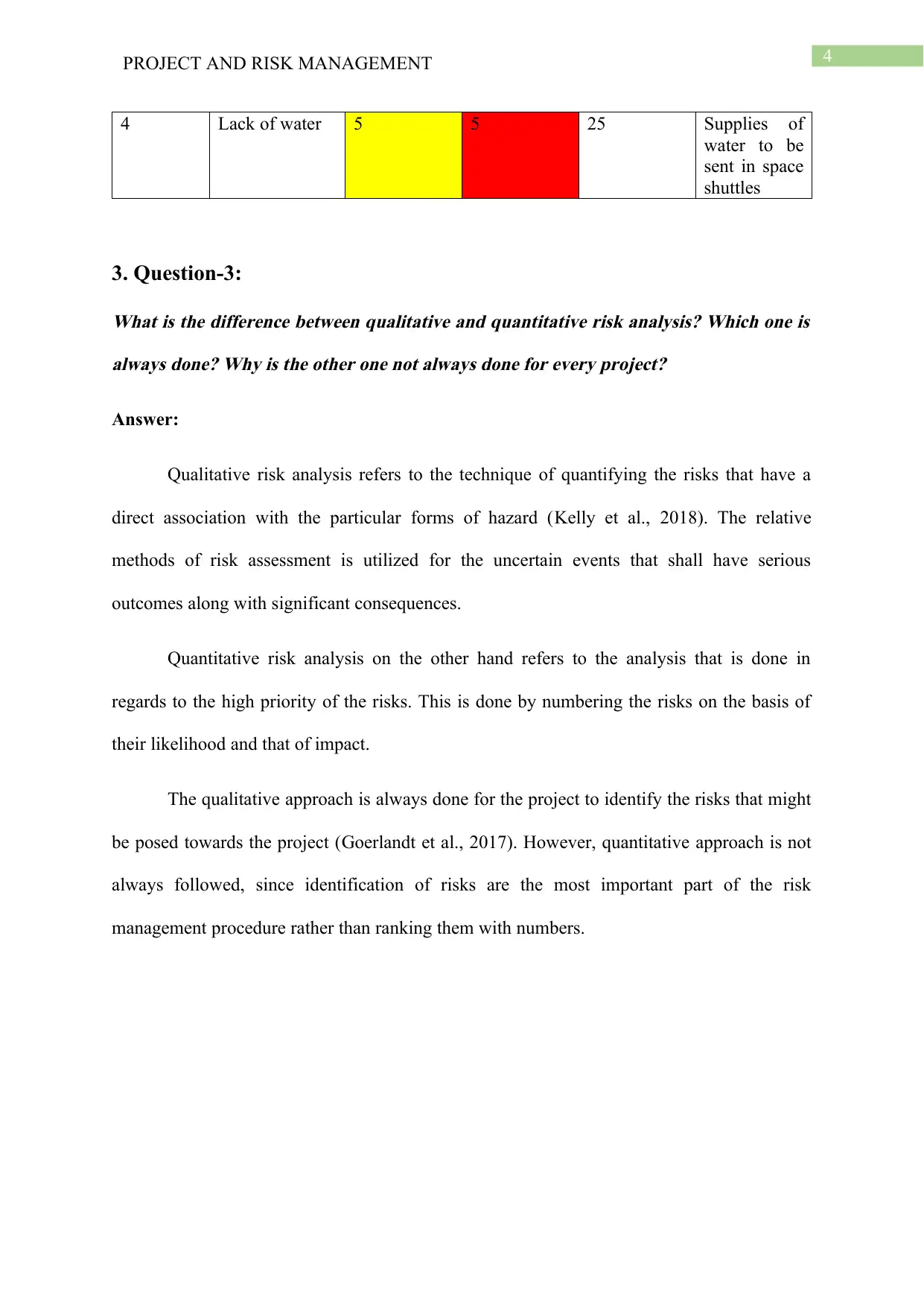
4PROJECT AND RISK MANAGEMENT
4 Lack of water 5 5 25 Supplies of
water to be
sent in space
shuttles
3. Question-3:
What is the difference between qualitative and quantitative risk analysis? Which one is
always done? Why is the other one not always done for every project?
Answer:
Qualitative risk analysis refers to the technique of quantifying the risks that have a
direct association with the particular forms of hazard (Kelly et al., 2018). The relative
methods of risk assessment is utilized for the uncertain events that shall have serious
outcomes along with significant consequences.
Quantitative risk analysis on the other hand refers to the analysis that is done in
regards to the high priority of the risks. This is done by numbering the risks on the basis of
their likelihood and that of impact.
The qualitative approach is always done for the project to identify the risks that might
be posed towards the project (Goerlandt et al., 2017). However, quantitative approach is not
always followed, since identification of risks are the most important part of the risk
management procedure rather than ranking them with numbers.
4 Lack of water 5 5 25 Supplies of
water to be
sent in space
shuttles
3. Question-3:
What is the difference between qualitative and quantitative risk analysis? Which one is
always done? Why is the other one not always done for every project?
Answer:
Qualitative risk analysis refers to the technique of quantifying the risks that have a
direct association with the particular forms of hazard (Kelly et al., 2018). The relative
methods of risk assessment is utilized for the uncertain events that shall have serious
outcomes along with significant consequences.
Quantitative risk analysis on the other hand refers to the analysis that is done in
regards to the high priority of the risks. This is done by numbering the risks on the basis of
their likelihood and that of impact.
The qualitative approach is always done for the project to identify the risks that might
be posed towards the project (Goerlandt et al., 2017). However, quantitative approach is not
always followed, since identification of risks are the most important part of the risk
management procedure rather than ranking them with numbers.
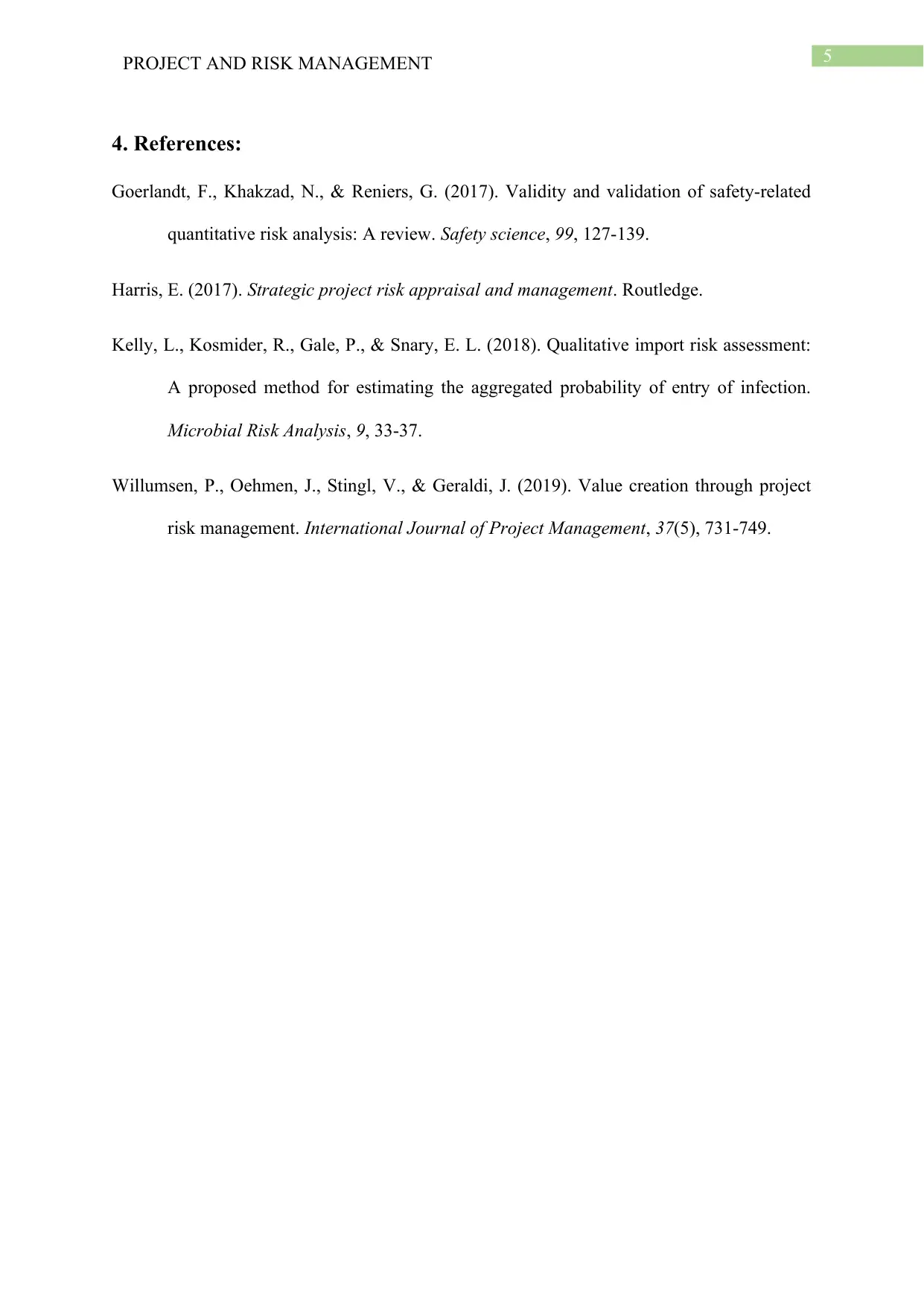
5PROJECT AND RISK MANAGEMENT
4. References:
Goerlandt, F., Khakzad, N., & Reniers, G. (2017). Validity and validation of safety-related
quantitative risk analysis: A review. Safety science, 99, 127-139.
Harris, E. (2017). Strategic project risk appraisal and management. Routledge.
Kelly, L., Kosmider, R., Gale, P., & Snary, E. L. (2018). Qualitative import risk assessment:
A proposed method for estimating the aggregated probability of entry of infection.
Microbial Risk Analysis, 9, 33-37.
Willumsen, P., Oehmen, J., Stingl, V., & Geraldi, J. (2019). Value creation through project
risk management. International Journal of Project Management, 37(5), 731-749.
4. References:
Goerlandt, F., Khakzad, N., & Reniers, G. (2017). Validity and validation of safety-related
quantitative risk analysis: A review. Safety science, 99, 127-139.
Harris, E. (2017). Strategic project risk appraisal and management. Routledge.
Kelly, L., Kosmider, R., Gale, P., & Snary, E. L. (2018). Qualitative import risk assessment:
A proposed method for estimating the aggregated probability of entry of infection.
Microbial Risk Analysis, 9, 33-37.
Willumsen, P., Oehmen, J., Stingl, V., & Geraldi, J. (2019). Value creation through project
risk management. International Journal of Project Management, 37(5), 731-749.
⊘ This is a preview!⊘
Do you want full access?
Subscribe today to unlock all pages.

Trusted by 1+ million students worldwide
1 out of 6
Related Documents
Your All-in-One AI-Powered Toolkit for Academic Success.
+13062052269
info@desklib.com
Available 24*7 on WhatsApp / Email
![[object Object]](/_next/static/media/star-bottom.7253800d.svg)
Unlock your academic potential
Copyright © 2020–2025 A2Z Services. All Rights Reserved. Developed and managed by ZUCOL.





